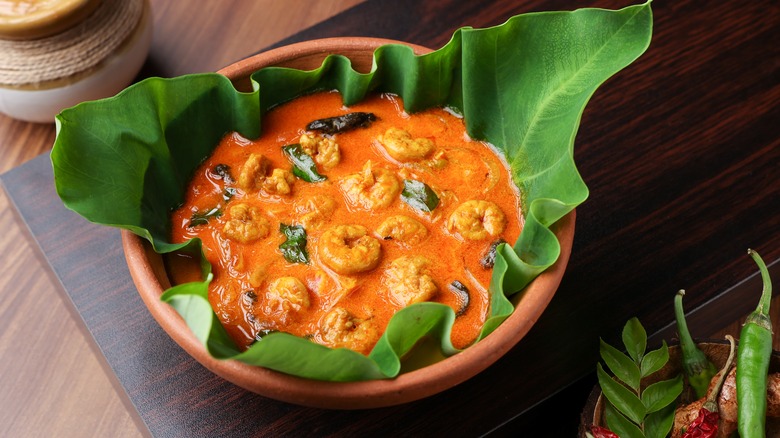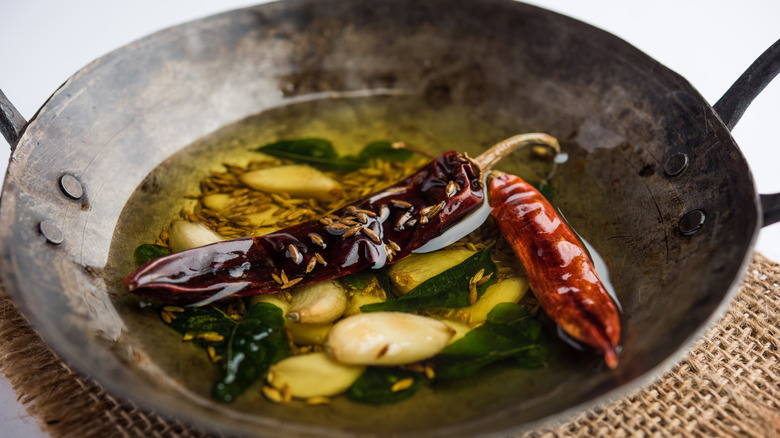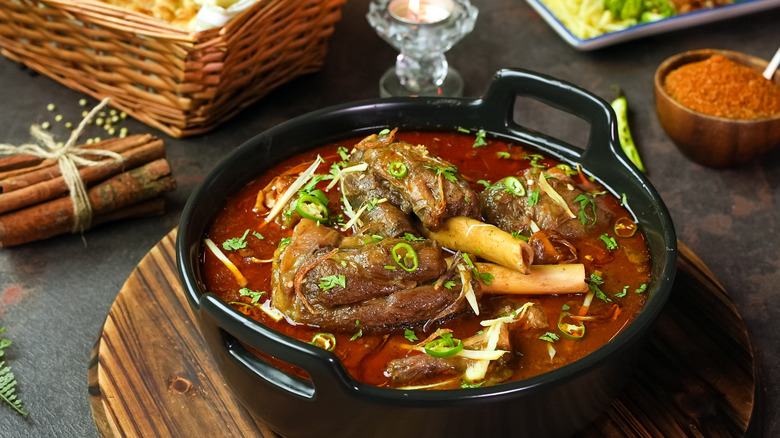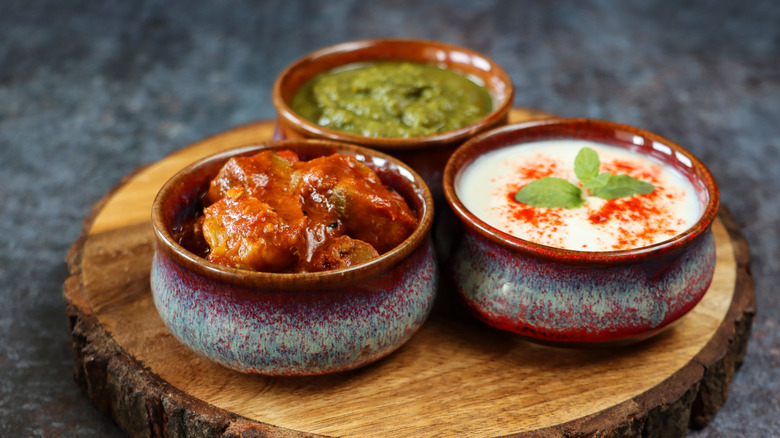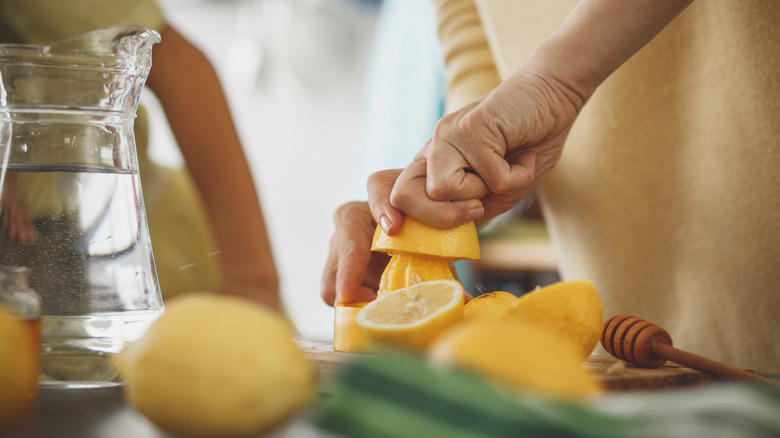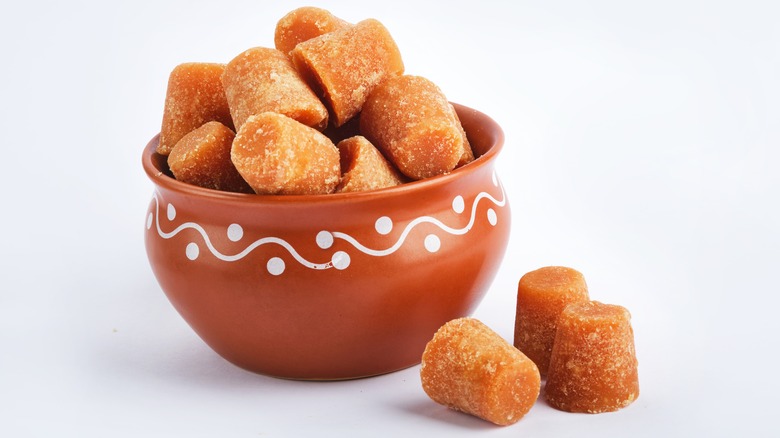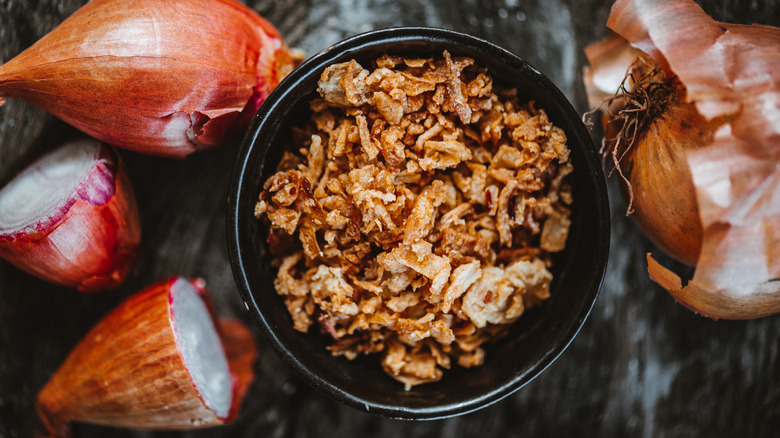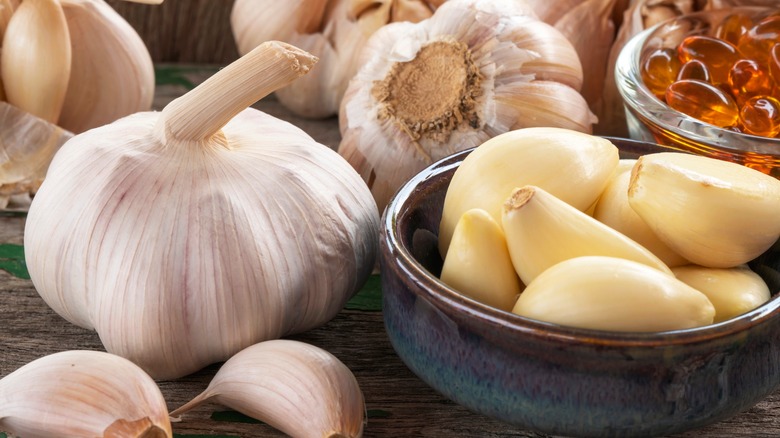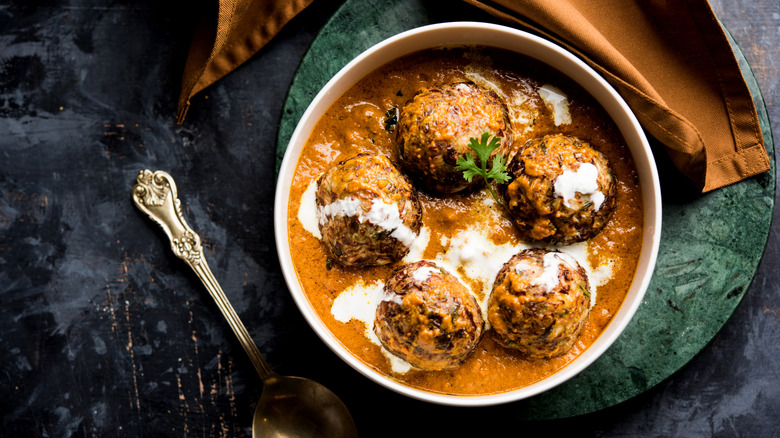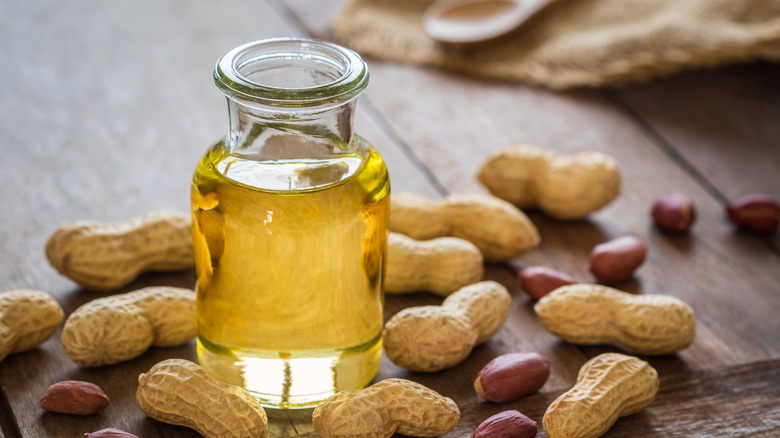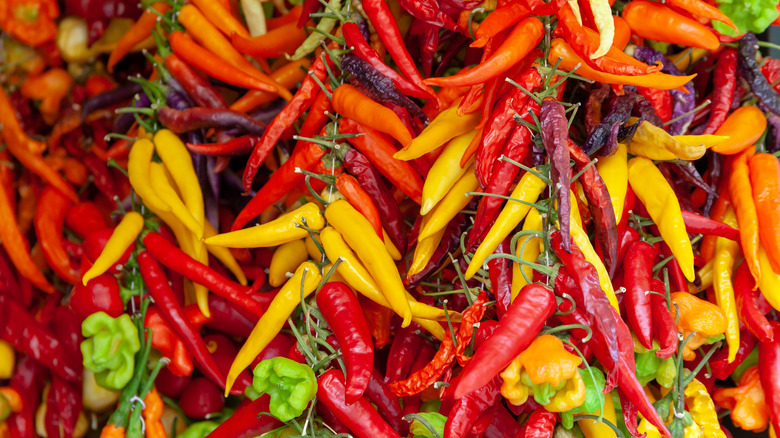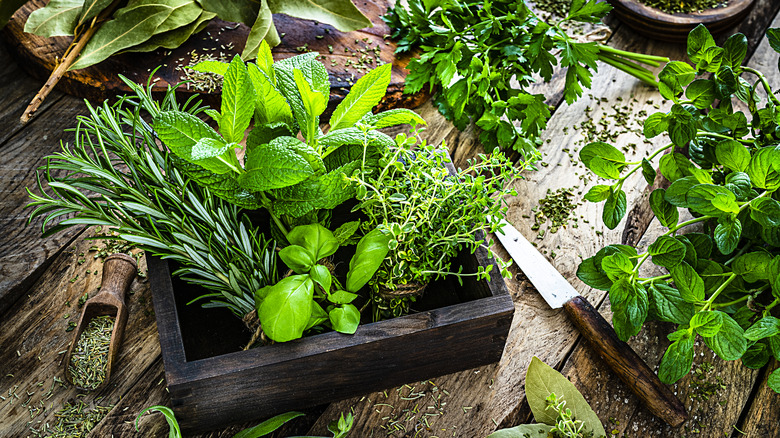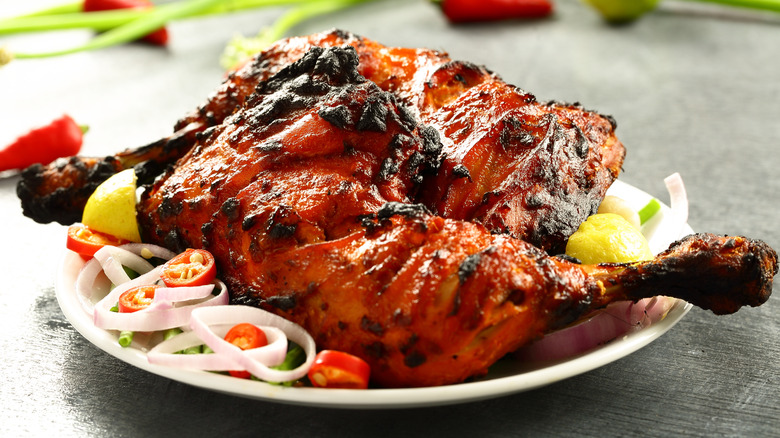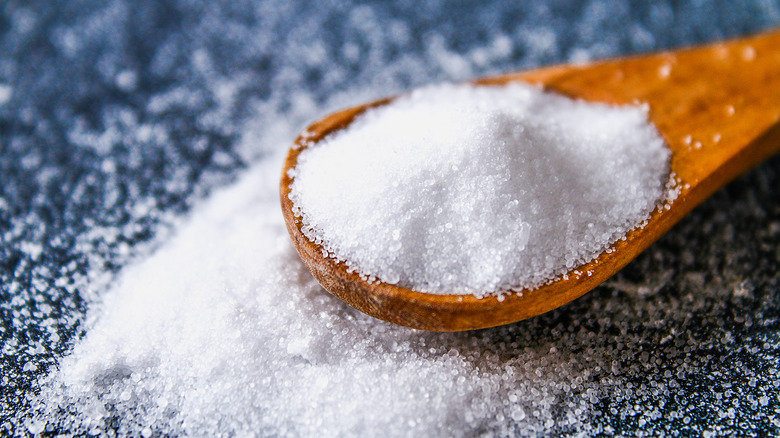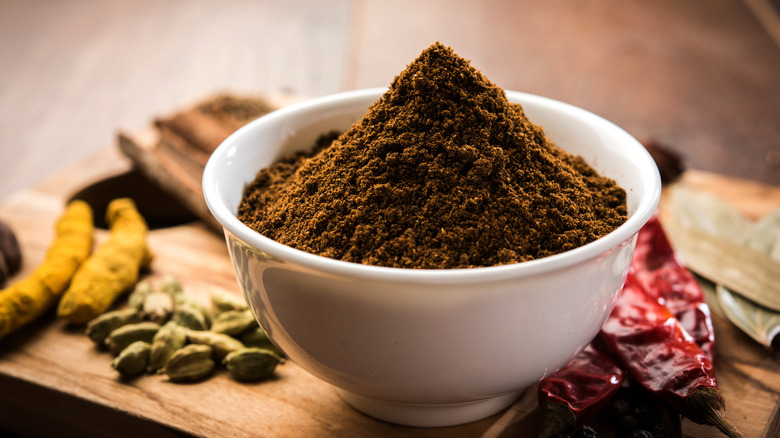15 Ways To Add More Flavor To Curry
We've all spent hours laboring over cooking a curry, only to sit down at the dining table, tuck in, and find that the dish we so lovingly cooked lacks flavor. Curry — from any cuisine — is an intricate dish to master, and if you want to make restaurant-quality curries at home, you need to know how to rescue a curry that's just not hitting the right spots — or prevent disaster next time.
We'll dive deep into the art of layering flavors, revealing expert, little-known techniques to transform your curries from ordinary to exceptional. You don't need elevated expertise or specialized components to accomplish this cooking skill set. In fact, we'll teach you how to unleash the potential of rudimentary ingredients, from fresh herbs to chutneys, oils, and salts — plus summer staples like charcoal — and, most importantly, when and how to add each element for maximum flavor potential. Are you ready to say goodbye to mediocre curries and hello to flavor-packed, lip-smacking bowls? Let the journey begin.
Infuse smokiness with charcoal
Although we often think of a smoky kitchen as a sign that the fire alarm is about to go off, smoke can also be an essential tool for the accomplished chef. The problem lies in recreating these flavors in your home, which is often unachievable for the home cook.
Enter the dhungar method. The technique begins by heating natural charcoal until it's burning, then placing it into a small bowl, before pouring hot ghee (or fat) over the charcoal, which causes it to smoke. Placing this smoking bowl in your curry pot and then covering the whole thing with a lid will capture that gorgeously smoky, sweet, and subtly bitter flavor within your curry. You don't want to smoke most curries for longer than a few minutes, or the delicate balance of the smoky aroma will be upset, pushing the dish toward overwhelming bitterness.
You can utilize the dhungar process across a wide array of curries. Although it perhaps complements the flavor of red meat best, there's no reason not to experiment with smoking vegetable curries, paneer curries, fish curries, and even lentil curries.
Add tempered spices on top
Most people know that one of the secrets to achieving restaurant-quality Indian curries at home is to layer your spices. However, what does that really entail, beyond the obvious? If you incorporate the whole spices at the beginning, followed by the ground spices, and save your finishing seasoning blends for the final stages, that's already impressive work — but let's go a touch further.
Tempering, referred to as "tadka" or "tarka" in Hindi, is an Indian cooking method that imparts new layers of flavor to your culinary creations. It involves heating oil in a small pan, spluttering spices and aromatics, and pouring the mixture over cooked curries, lentils, and rice dishes. The ingredients you use are up to your discretion: Garlic, dried chilis, mustard seeds, cumin seeds, coriander seeds, and even split lentils are customary choices.
Integrating the tadka method is the perfect way to infuse more flavor into your curry, whether because you've not added enough chili (we've all been there) or you've realized your plate doesn't have the depth of flavor you're seeking. It's also ideal for curries that have lost their punchiness and need refreshing.
Finish with diverse garnishes
Are garnishes the key to an attractive presentation or an afterthought? What if we told you they play a vital role in building flavor? For example, fresh slivers of julienned ginger combine with rich and aromatic sauces, infusing a warm pepperiness. Meanwhile, a sprinkle of pomegranate arils introduces vibrancy and counteracts intense spiciness with its subtle tartness. There's no limit to the imagination: Pink-tinged pickled onions and twisted lime both provide acidity, toasted nuts (we recommend almonds, peanuts, and fried cashews) add an oft-missing texture and nuttiness, and fresh herbs such as mint and cilantro, chives, or fried curry leaves will deliver earthy zestiness.
Don't shy away from culinary-grade edible flowers, either. Most edible flowers, such as chive flowers, daikon, and nasturtium, contribute a mild flavor: oniony, bitter, and peppery, respectively. Even floral, heavily fragranced flowers — rose and jasmine — can elevate the character of a creamy, rich, and thick Mughlai-inspired curry. Two caveats: Make sure you identify flowers correctly, as some can be poisonous, and many blooms look alike. Secondly, avoid any blossoms sprayed with pesticides.
Cook with chutneys and pickles
You may be used to spreading condiments on sandwich bread or burger buns or pairing them with cheese. There's no doubt that chutneys and pickles are extraordinarily versatile, but have you ever added them to curries?
Chutney pairs perfectly with robust and savory dishes like curry as the sweet undertones counteract the spicier capsaicin from chili peppers, and the acidity plays much the same role as lemon juice or tamarind. Mango chutney, with its complex crystalized sweet-spicy flavors, is a favorite. Less orthodox choices like tamarind chutney will add flavor through caramelized jaggery and sourness, while coconut chutney stirred through hot and punchy South Indian classics will add a nutty creaminess that pairs perfectly.
On the other hand, pickles — especially chili pickles — are an excellent way to involve extra spice and flavor. Opt for the knock-your-socks-off spicy Naga pickles if you need to up the heat, while garlic pickle is ideal for anyone who jokes that there can never be enough garlic in curry.
A dash of acidity goes a long way
You may have added tomatoes to provide umami, caramelized your onions to bring a hint of sweetness, and added a dash of salt — but did you account for acidity? Adding acidic ingredients in large quantities will fulfill the sour component of the five taste sensations. In limited quantities, astringent elements counterbalance excessive sweetness, bitterness, or spiciness in foods and help to enhance latent flavors.
Tangy ingredients are a traditional addition to many Asian foods, including curries. These include liquids such as tamarind paste — or the shortcut version, tamarind chutney — lemon or lime juice, and natural yogurt are all prime examples. The benefit of liquid acids is that the ingredient spreads uniformly throughout the dish. Alternatively, you can sprinkle ground spices over a curry while serving or add them while cooking. The most common additions include amchur powder, also known as dried mango powder, and dried pomegranate powder, called anardana powder in Hindi.
Ultimately, sour ingredients add brightness, freshness, and a distinctly tart flavor to foods. It's an excellent and easy way to add additional seasoning. The best part is flavoring with acidic components doesn't require complicated techniques or excess time.
Balance out the spiciness with jaggery
Curries are generally associated with hot, fiery, and punchy flavors. That's true — but if you want to add more flavor to your curry, you should reach for sugar. It's standard to see palm sugar or coconut sugar crop up in recipes for Thai dishes, but many people don't think to include an element of sweetness in Indian food. Interestingly, many regional cuisines across India traditionally add jaggery, an unrefined cane sugar similar to palm sugar (although it has noticeable differences), to curries and lentil dishes, not just sweets.
Jaggery has a beautiful caramelized flavor similar to molasses and a deep rich golden hue. You can grate it into curries to add a depth of flavor, which perfectly complements rich aromatic spices, robust chilis, and acidic ingredients. It's particularly well suited to West and South Indian dishes, and a little goes a long way in lifting the complex undertones of a plate. You can substitute brown sugar for jaggery in a pinch, although it lacks the delicacy and is comparatively sweeter, so use less.
Sprinkle over some crispy onions
Hundreds of miles away in South Asia, crispy onions — locally known as birista — are indispensable. The versatile ingredient is most commonly employed by home cooks and professional chefs to add texture between biryani layers. Yet, looking beyond their most stereotypical use is a world of flavor.
One method to incorporate crispy onions is while cooking your curry. You can even substitute them for the usual cooking onions. This simple swap expedites your curry-making process and introduces extra sweetness, robust umami, and a heightened depth of flavor. Traditionally, the crispy onions pair with traditional meat-based curries from the North-West Indian regional cookery schools. However, vegetable curries — often lacking in natural umami — can also benefit from the added flavor. If you would rather retain the crunchy texture of birista, use them as a garnish. You'll still benefit from the intensely sweet aroma.
To make your own crispy onions, finely slice sweet onions and deep-fry the pieces over low heat until golden brown. The leftover oil has a gorgeous aroma and can further flavor your curries. Alternatively, save time and purchase crispy onions at any specialty South Asian store.
Up the aromatics
It is common knowledge that when you're suffering from the flu, food just never tastes as good. Scientists now understand that smell and taste make up flavor, since the throat and the nose share a common airway. Aromatics, as the name implies, are ingredients that contribute scent to our food. It's now easy to understand why it's so paramount that you add enough aromatics to your curry.
Ancient cultures ostensibly comprehended the role of aromatics in stimulating our taste buds, evident from the prevalence of these fragrant elements in traditional cuisines. When you make Thai curries, don't skimp on shallots, galangal, and lemongrass, all of which offer gorgeous fragrances and contribute complex taste characteristics. Indian curries will benefit from the elemental trio of fried onion, ginger, and garlic. Beyond that, spices such as cinnamon, cardamom, cloves, star anise, nutmeg, and mace will help by flavoring your curries.
Stir through some dairy
Dairy has two primary purposes: Adding flavor and muting the effect of overpowering ingredients, like chili. Indian cuisine — particularly North Indian plates, Punjabi being the most recognizable — heavily depends on dairy for flavor.
Thick yogurt counteracts punchy flavors while contributing a distinctively creamy, smooth texture and hint of sharp acidity. If you need to add brighter, robust flavors with a sour undertone, then yogurt is the right choice. In contrast, dairy-based cream provides a mellow, buttery flavor and barely noticeable sweetness. These characteristics make it superior for rounding out flavors. While both yogurt and cream are typically stirred through during the cooking process, they possess the increased potential to be drizzled or dolloped atop bowls, creating an intriguing and contrasting effect.
Southeast Asian curries are more likely to rely on coconut milk than dairy. While they both provide the same thick, creamy, and velvety texture to curry sauces, the flavor is utterly different; while dairy has the ability to be sour, sweet, or mild, on the other hand, sweet, nutty, and tropical aromas dominate coconut milk.
Don't always use a neutral oil
Infusing flavor into your curries starts from the beginning. Most of us instinctively reach for rapeseed or vegetable oil when we start cooking — yet by using such neutral-flavored fats, you could be missing out on a deeper savory profile.
Conversely to the U.S., there's no clear winner for the most popular cooking fat, with India's preference split across regional boundaries. For example, warm and peppery-tasting mustard oil is the favored fat of Bihar, West Bengal, and Bangladesh. In the U.S., it has a controversial legacy, often labeled only "suitable for external use" due to high levels of erucic acid, with only one brand officially approved by the FDA. If you frequently cook South Indian or South Asian curries, reach for the tropical nutty aroma of unrefined coconut oil or the intense, earthy flavor of toasted sesame oil. Both are best used in small quantities, as the flavor can overpower a dish unless used in moderation.
Meanwhile, chefs from Western India prefer the dynamic nutty aroma of roasted groundnut oil, popularized by Portuguese colonists in the 1800s. Finally, how could we forget ghee — a gloriously rich, buttery, nutty fat with incredible depth of flavor? You can make ghee at home by slowly heating butter until the milk fats separate, and although it's a labor of love, homemade ghee is well worth the effort.
Experiment with different varieties of chili
Most of us don't have access to a vast array of peppers. So, what's the solution, and how do you cook with chilis? Firstly, consider using both fresh and dried chili peppers in your curry cooking. Fresh chili peppers have a less intense, bright, and slightly sweet flavor when compared to their smoky, bitter, and fiercely spicy dried versions. Using both instantly adds more dimension to your curry sauce, and with so many types of peppers out there, there's no harm in buying what you can find in your area and going to town with them in your curry.
Interesting chili varieties to look for include fresh Thai bird eye chilis, ideal for the fragrant, sour, and pungent Thai curries; powdered Kashmiri chilis, which provide mild heat but fantastically vibrant coloring; and fresh ghost peppers (bhut jolokia) from Northeast India, known as one of the most potent varieties in the world, with a dangerously hot and fruity essence.
Add fresh and dried herbs to your curries
Herbs are the aromatic cornerstone of numerous world cuisines. Some herbs — often the dried variety — can be added at the onset, while others are best stirred through the curry to preserve their more delicate flavors. Either way, you need to use fresh herbs to boost the character of your cooking — it makes a monumental difference.
Examples of herbs that infuse a dish with flavor, which you should use at the beginning of your recipe, include bay leaves, curry leaves, kaffir lime leaves, and pandan leaves. Be sure to use Indian bay leaves, not the European counterpart; while European bay leaves are citrusy, Indian bay leaves (tej patta) offer a sweet flavor reminiscent of cinnamon. Curry leaves and kaffir lime leaves both retain zesty notes, but while curry leaves verge on sharp, kaffir lime leaves are more bitter. Pandan leaf is floral, grassy, and coconut-scented — perfect for curry pastes or marinades.
To achieve the most from tender herbs, such as cilantro, mint, Thai basil, and dried fenugreek, stir them into the curry before serving. Ultimately, fresh herbs provide a flavor that nothing else can: complex floral, grassy, and lively vibrancy.
Marinate your proteins
When you have spent so much time perfecting the flavor of your curry base, it's tempting to throw your main ingredients — seafood, meat, cheese, or vegetables — into the sauce and leave it to cook. But wait — a whole world of flavor is waiting to be unlocked, with the key being the art of marination.
Of all the cuisines that enjoy curry, India is the one that most frequently employs marination techniques. If you've ever eaten tandoori-style chicken, you know that leaving your meat to tenderize in a rub made of yogurt and smoky spices infuses it with a whole new depth of character. Interestingly, we can apply the same procedure to more delicate proteins, including seafood, paneer, and vegetables — simply marinate them for less time. Once they've marinated, grill them until charred, then chuck them into your curry sauce and savor the new nuances on your palate.
Don't be afraid to add more salt
It's the most elementary answer of all but one we often forget. If you're struggling to place why your curry lacks flavor, a pinch of salt is probably the remedy you need. While we've covered several other additions that can enhance the complexity of flavors in your curry, salt stands out as the only one that won't introduce its own taste; instead, it simply enhances the existing seasoning. For example, a small pinch of salt boosts sweet, savory, and sour flavor notes, while a liberal dosage enriches your curry with robust umami.
Salt helps you cook ingredients properly, too. Adding salt when cooking onions helps draw out the water, enabling the onions to unleash their intense flavors without being diluted. This tip is vital because one of the most common curry cooking mistakes is not extracting enough flavor from your onions. A similar approach works for tomatoes; salt draws out the water, allowing them to melt into a jammy, sweet curry base.
Try using regional spice blends
Across many home-cooking communities, spice blends have a poor reputation. There's a reason someone might recoil at the mention of spice blends — we typically think of curry powder, which in its true origins was a messy attempt by British colonists to capture the flavors of traditional Indian cuisine. In the modern age, many other countries have adopted unique variations of "curry powder," including Japan, Malaysia, and Singapore.
Other modern spice blends, such as pav bhaji masala, chole masala, and butter chicken masala, to mention but a few, are now widespread across India. Cooks use these easy, premixed spices to enhance the flavor of their homemade curries.
But what about age-old, traditional, and regional spice mixes? Warming and fragrant garam masala may be the most renowned, but to add an unusual and memorable flavor to your curry dishes, opt for the pungent goda masala, named for its sweet aroma. Made with stone flowers, among other specialistic spices, it's the perfect way to infuse those flavors without buying individual packets. Traditional curry blends aren't limited to the Asian continent; Northeastern Africa boasts a hot and peppery berbere mix, while North Africa enjoys smoky harissa.
Static Media owns and operates The Daily Meal, Mashed, Food Republic, and Tasting Table.
